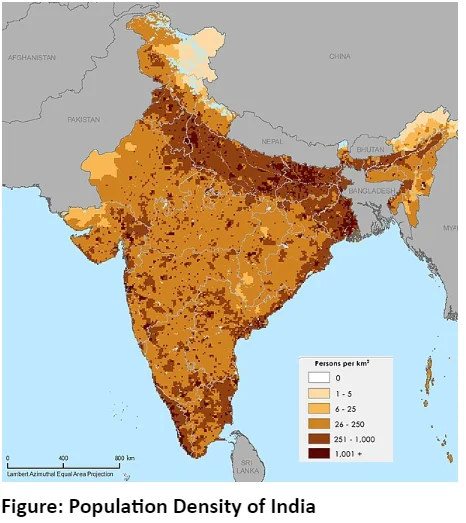India’s population is a significant global demographic factor, surpassing China to become the world’s most populous nation. With a current population of 1.43 billion, India faces challenges such as resource pressure and socio-economic issues due to its immense size. Understanding population distribution, density, and growth trends is crucial for effective planning and development.
Understanding India’s Population
A. Distribution of Indian Population
- Population Distribution: U.P., Maharashtra, Bihar, West Bengal, Andhra Pradesh, Tamil Nadu, Madhya Pradesh, Rajasthan, Karnataka, and Gujarat together comprise 76% of the country’s total population.
- The Disparity in Population Distribution: States like Jammu & Kashmir, Arunachal Pradesh, and Uttarakhand have small population shares despite their large geographical areas.
- Factors Affecting Distribution: Physical factors such as climate, terrain, and water availability, along with socio-economic and historical factors, determine population distribution.
- Impact of Physical Factors: North Indian Plains, deltas, and Coastal Plains have higher population densities compared to interior districts of southern and central Indian states, the Himalayas, and some northeastern and western states.
- Role of Development in Population Distribution: Irrigation development in Rajasthan, mineral and energy resources in Jharkhand, and transport network development in peninsular states have led to moderate to high population concentrations in previously sparsely populated areas.
B. Population Density
- Meaning of Population Density: Population density is a measure of the number of individuals per unit area, providing insight into how people are distributed across land.
- It is a crude measure of the human and land relationship.
- Population Density India: It was 382 persons per sq km in 2011, showing a steady increase from 117 persons/sq km in 1951.
- Population Density in India (2011) is 382 persons per sq km.
-
- Density of population is expressed as the number of persons per unit area.
- Physiological density: Computed by dividing the total population by the net cultivated area.
- Agricultural density: Computed by dividing the agricultural population by the net cultivable area, where the agricultural population encompasses cultivators, agricultural labourers, and their families.
|
- Spatial Variation: Population density ranges from 17 persons/sq km in Arunachal Pradesh to 11,297 persons/sq km in Delhi.

- Regional Densities: Bihar (1102), West Bengal (1029), and Uttar Pradesh (828) have higher densities in northern India, while Kerala (859) and Tamil Nadu (555) lead in the peninsular region.
- Moderate Densities: Assam, Gujarat, Andhra Pradesh, Haryana, Jharkhand, and Odisha have moderate population densities.
- Low Densities: The Himalayan region, hill states, and northeastern states (excluding Assam) have relatively low population densities.
- Union Territories: Union Territories (excluding Andaman and Nicobar Islands) have very high population densities.
- Physiological and Agricultural Densities: Population density offers a basic understanding of the human-land relationship, Physiological and Agricultural densities are crucial for assessing pressure on cultivable land in a country like India with a significant agricultural population.
C. Population Growth
- Definition of Population Growth: Refers to the change in the number of inhabitants over a specific period. Population growth has two components:
- Natural Growth: Assesses the crude birth and death rates.
- Induced Growth: is explained by the volume of inward and outward movements of people in any given area.
- Natural Growth of Population = Births – Deaths
- Actual Growth of Population = Births – Deaths + In Migration – Out Migration
- Decadal growth rate of population in India between 2001- 2011 was 17.64%. It decreased from 21.54% during 1991- 2001.
- India’s population growth over the past century has been influenced by annual birth and death rates, as well as migration, resulting in various trends.
- Four phases of growth have been identified within this period as given below.
| Phase |
Key Characteristics |
| Phase I: Stagnant Phase (1901-1921) |
- Very low growth, negative during 1911-1921.
- High birth and death rates due to poor health & medical services, illiteracy, and inefficient distribution of basic necessities.
|
| Phase II: Steady Growth (1921-1951) |
- Decrease in mortality due to better health, sanitation, transport, and communication.
- High birth rate led to higher growth.
|
| Phase III: Population Explosion (1951-1981) |
- Rapid fall in mortality, but high fertility rate; annual growth rate was 2.2%.
- Improved living conditions; Increased international migration to India (Tibetans, Bangladeshis, Nepalis, and people from Pakistan)
|
| Phase IV: Decelerating Growth (Post-1981) |
- Growth rate started slowing, though still high.
- Downward trend in birth rate due to increased marriage age, better quality of life, and female education.
|
| Population Momentum: Tendency of a highly fertile population that has been increasing rapidly in size to continue to do so for decades even after a substantial decline in fertility. This results from the youthful age structure of such a population. |
Conclusion
- India’s population distribution varies greatly across regions, influenced by factors like geography, development, and historical trends.
- The steady increase in population density reflects the growing pressure on land and resources.
- Despite the slowing growth rate, India’s population remains dynamic, requiring careful management and planning for sustainable development.
![]() May 2, 2024
May 2, 2024
![]() 16307
16307
![]() 0
0
